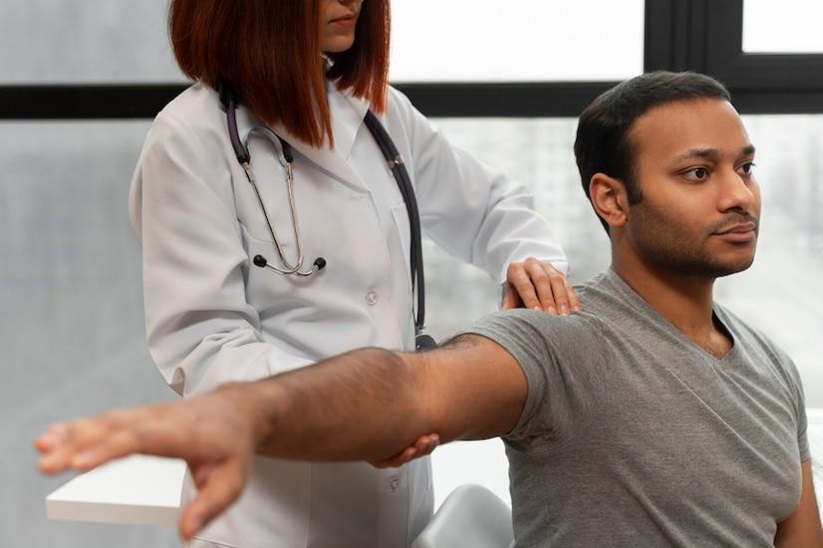
Are you struggling with shoulder pain and wondering if it’s time to see a specialist? Look no further because we have all the information you need to navigate your care with a shoulder doctor. From understanding common shoulder conditions to finding the right specialist, we’ve got you covered.
Whether you’re dealing with a sports injury, arthritis, or a rotator cuff tear, a shoulder doctor can provide expert diagnosis and customized treatment options. With their specialized knowledge and cutting-edge technology, they can help you regain full mobility and live a pain-free life.
So, if you’re tired of suffering from shoulder discomfort and limited range of motion, it’s time to explore the world of shoulder specialists. Let’s embark on this journey together and find the right healthcare professional to give you the relief you deserve.
Common Shoulder Injuries And Conditions
Shoulder injuries and conditions are more common than you think. The shoulder is a complex joint that allows for a wide range of motion but is also prone to injuries and wear and tear. Here are some of the most common shoulder injuries and conditions:
- Rotator cuff tears: The rotator cuff is a group of four muscles and tendons surrounding the shoulder joint. Tears in the rotator cuff can occur due to repetitive motion, overuse, or traumatic injury. Symptoms may include pain, weakness, and limited range of motion.
- Shoulder impingement: Shoulder impingement occurs when the tendons of the rotator cuff become inflamed and rub against the acromion, a bony prominence on the shoulder blade. This can cause pain, swelling, and difficulty raising the arm.
- Frozen shoulder: Frozen shoulder, also known as adhesive capsulitis, is characterized by stiffness and pain in the shoulder joint. It usually develops gradually and can limit the range of motion.
- Shoulder arthritis: Arthritis can affect any joint, including the shoulder. Osteoarthritis, rheumatoid arthritis, and post-traumatic arthritis are some of the common types of arthritis that can cause shoulder pain and stiffness.
- Shoulder dislocation: A shoulder dislocation occurs when the upper arm bone pops out of the socket. This can happen due to a fall, sports injury, or trauma. It often causes intense pain and requires immediate medical attention.
Now that you know the common shoulder injuries and conditions, let’s explore the benefits of seeing a shoulder specialist.
Benefits Of Seeing A Shoulder Specialist
When it comes to your shoulder health, seeing a specialist can make all the difference. Here are some benefits of consulting a shoulder doctor:
- Expert diagnosis: Shoulder specialists have extensive knowledge and experience in diagnosing shoulder injuries and conditions. They can perform a thorough examination, review your medical history, and order any necessary imaging tests to determine the cause of your shoulder pain.
- Customized treatment options: Shoulder specialists understand that every patient is unique, and they tailor treatment plans to individual needs. Whether it’s physical therapy, medications, injections, or surgery, they recommend the most appropriate treatment options based on your specific condition and lifestyle.
- Access to cutting-edge technology: Shoulder specialists often have access to the latest advancements in medical technology. From minimally invasive arthroscopic surgery to regenerative medicine techniques, they can offer state-of-the-art treatments to speed up your recovery and improve outcomes.
- Collaborative approach: Shoulder specialists work closely with a multidisciplinary team, including physical therapists, radiologists, and orthopedic surgeons. This collaborative approach ensures that you receive comprehensive care throughout your treatment journey.
Now that you understand the benefits of seeing a shoulder specialist let’s discuss how to find a qualified shoulder doctor.
What To Expect During A Shoulder Specialist Appointment
You can expect a comprehensive evaluation of your shoulder health during your shoulder specialist appointment. Here’s what typically happens during a visit:
- Medical history and physical examination: The shoulder specialist will review your medical history, including any previous injuries, surgeries, or ongoing medical conditions. They will then perform a physical exam to assess your shoulder’s range of motion, strength, and stability.
- Imaging tests: Depending on your symptoms and physical examination findings, the shoulder specialist may order imaging tests, such as X-rays, MRI scans, or ultrasound. These tests can provide detailed images of the shoulder joint and help diagnose it accurately.
- Discussion of treatment options: Once the diagnosis is made, the shoulder specialist will discuss the available treatment options with you. They will explain the pros and cons of each approach and answer any questions or concerns you may have.
- Development of a treatment plan: Based on your diagnosis, preferences, and lifestyle, the shoulder specialist will work with you to develop a personalized treatment plan. This plan may include a combination of conservative measures like physical therapy, medications, lifestyle modifications, or surgical intervention if necessary.
Now that you know what to expect during a shoulder specialist appointment, let’s explore the different treatment options for shoulder injuries and conditions.
Diagnosing Shoulder Injuries And Conditions
Diagnosing shoulder injuries and conditions requires careful evaluation, medical history review, and diagnostic tests. Here are some of the standard diagnostic methods used according to an orthopedic surgeon at Ulric Bigby, MD:
- Physical examination: The first step in diagnosing shoulder injuries and conditions is a thorough physical examination. The specialist will assess your shoulder’s range of motion, strength, stability, and any signs of inflammation or deformity.
- Imaging tests: Imaging tests, such as X-rays, MRI scans, CT scans, or ultrasounds, help visualize the internal structures of the shoulder joint. They provide valuable information about bone fractures, soft tissue damage, and joint abnormalities.
- Arthroscopy: Arthroscopy is a minimally invasive procedure that allows the shoulder specialist to directly visualize the inside of the joint using a tiny camera called an arthroscope. This procedure helps identify and treat various shoulder conditions, including rotator cuff tears, labral tears, and loose bodies.
- Diagnostic injections: The shoulder specialist may sometimes perform diagnostic injections to determine the source of shoulder pain. These injections involve injecting a local anesthetic or corticosteroid into the shoulder joint or surrounding structures to relieve pain and confirm the diagnosis temporarily.
Once the shoulder specialist has diagnosed your condition, they will discuss the most appropriate treatment options.
Treatment Options For Shoulder Injuries And Conditions
The treatment options for shoulder injuries and conditions vary depending on the specific diagnosis, severity of symptoms, and individual factors. Here are some common treatment approaches:
- Conservative measures: In many cases, shoulder injuries and conditions can be effectively managed with conservative measures. These may include rest, physical therapy, non-steroidal anti-inflammatory drugs (NSAIDs), corticosteroid injections, and lifestyle modifications.
- Surgical intervention: If conservative treatments fail to provide relief or if the condition is severe, surgical intervention may be necessary. Shoulder surgery can range from minimally invasive arthroscopic procedures to open surgeries, depending on the nature of the injury or condition.
- Rehabilitation and physical therapy: Rehabilitation and physical therapy play crucial roles in recovery after shoulder surgery or as standalone treatments. Physical therapists work closely with shoulder specialists to design personalized exercise programs that improve strength, flexibility, and range of motion.
- Regenerative medicine: Regenerative medicine techniques, such as platelet-rich plasma (PRP) therapy or stem cell injections, are emerging as alternative treatment options for certain shoulder conditions. These therapies promote the body’s natural healing processes and accelerate tissue repair.
Now that you know the treatment options, let’s discuss rehabilitation and recovery after shoulder surgery.
Rehabilitation And Recovery After Shoulder Surgery
Rehabilitation and recovery are essential components of the healing process after shoulder surgery. The goal of rehabilitation is to restore strength, flexibility, and function to the shoulder joint. Here’s what you can expect during the rehabilitation and recovery phase:
- Physical therapy: Physical therapy is a critical component of post-surgical rehabilitation. Your physical therapist will guide you through exercises and stretches to regain strength and mobility in your shoulder gradually. They will also teach proper body mechanics and techniques to prevent further injuries.
- Pain management: Pain is a common concern after shoulder surgery. Your healthcare team will provide pain management strategies to ensure your comfort during recovery. This may include medications, ice packs, heat therapy, or transcutaneous electrical nerve stimulation (TENS).
- Gradual return to activities: As your shoulder heals, your shoulder specialist and physical therapist will guide you through a gradual return to activities and sports. They will provide specific recommendations on when it’s safe to resume certain movements and exercises to prevent re-injury.
- Follow-up appointments: Regular appointments with your shoulder specialist are crucial for monitoring your progress and making necessary adjustments to your treatment plan. These appointments allow your healthcare team to address concerns, track your healing, and ensure optimal recovery.
Now that you understand the rehabilitation and recovery process let’s explore some tips for preventing shoulder injuries.
Tips For Preventing Shoulder Injuries
Prevention is always better than cure when it comes to shoulder injuries. Here are some tips to help you maintain shoulder health and prevent injuries:
- Maintain good posture: Poor posture can contribute to shoulder pain and dysfunction. Practice good posture by keeping your shoulders relaxed, and avoid slouching or hunching.
- Warm-up and stretch: Before engaging in any physical activity or exercise, warm up your muscles and perform stretching exercises to prepare your shoulders for movement. This helps reduce the risk of strains or tears.
- Strengthen your shoulder muscles: Regularly perform exercises that target the muscles in your shoulders and upper back. Strong muscles provide support and stability to the shoulder joint, reducing the risk of injuries.
- Use proper lifting techniques: When lifting heavy objects, use your legs and core muscles instead of relying solely on your shoulders. Avoid lifting objects that are too heavy for you, and ask for help when needed.
- Take breaks during repetitive activities: If your work or hobbies involve repetitive shoulder movements, take regular breaks to rest and stretch your muscles. This helps prevent overuse injuries and allows your shoulders to recover.
Following these tips can significantly reduce the risk of shoulder injuries and maintain optimal shoulder health.
Conclusion: Taking Care Of Your Shoulder Health
Your shoulders are crucial in your daily activities, and any pain or limitation can significantly impact your quality of life. By understanding common shoulder injuries and conditions, seeking the expertise of a shoulder specialist, and following proper prevention strategies, you can take control of your shoulder health.
Remember to listen to your body and seek medical attention if you experience persistent shoulder pain or limited mobility. A shoulder specialist can provide an accurate diagnosis, personalized treatment options, and guidance throughout your recovery journey.
Don’t let shoulder pain hold you back any longer. Consult a shoulder specialist today to take the first step towards a pain-free life. Your shoulders deserve the best care, and with the correct healthcare professional, you can regain full mobility and enjoy life to the fullest.




